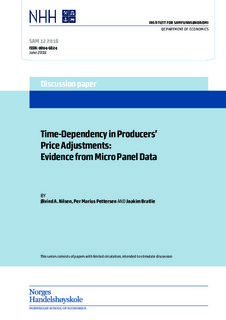Time-Dependency in Producers’ Price Adjustments: Evidence from Micro Panel Data.
Working paper

Åpne
Permanent lenke
http://hdl.handle.net/11250/2502742Utgivelsesdato
2018-06Metadata
Vis full innførselSamlinger
- Discussion papers (SAM) [657]
Sammendrag
Existing micro evidence of firms’ price changes tends to show a downward sloping hazard rate – the longer the price of a product has remained the same, the less likely it is that the price will change. Using a panel of Norwegian plant- and product-specific prices, we also find a downward sloping hazard when applying a Kaplan–Meier model. After having controlled for both observed and unobserved characteristics, we find flat hazards with spikes in the first and
twelfth months. This suggests time-dependent price-setting by at least some of the producers. The spike after 12 months might be explained by seasonal demand effects, but also by the pricing season effect related to information acquisition and processing, negotiation and signing of price contracts. The revealed price adjustment pattern is at odds with the predictions of the Calvo model, a central element in many dynamic stochastic general equilibrium models, as this assumes constant frequencies of price adjustments over time. Our empirical findings instead point to a modified Calvo model where firms in some periods experience lower menu costs. Finally, the empirical findings may have implications for the effectiveness of monetary policy interventions.